
The Village of Lakewood is a village in McHenry County, Illinois, United States. It was incorporated as a village on July 10, 1933. Per the 2020 census, the population was 4,283. Although commonly referred to as Lakewood, the town's proper name is preceded by 'The Village of'.

Sleeping Bear Dunes National Lakeshore is a United States National Lakeshore located along the northwest coast of the Lower Peninsula of Michigan in Leelanau and Benzie counties near Empire, Michigan. The park covers a 35-mile-long (56 km) stretch of Lake Michigan's eastern coastline, as well as North and South Manitou islands. This Northern Michigan park was established primarily because of its outstanding natural features, including forests, beaches, dune formations, and ancient glacial phenomena. The lakeshore also contains many cultural features including the 1871 South Manitou Island Lighthouse, three former stations of the Coast Guard and an extensive rural historic farm district. In 2011, the area won the title of "The Most Beautiful Place in America" from Good Morning America. In 2014, a section of the park was named the Sleeping Bear Dunes Wilderness by the United States Congress.

Lake Claire is a neighborhood on the east side of Atlanta, Georgia, United States, comprising approximately 1,200 homes. It is situated entirely in the DeKalb County side of the city, east of Candler Park, north of Kirkwood, west of Decatur, and south of Druid Hills.
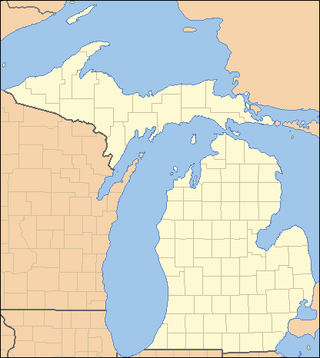
This is a list of properties on the National Register of Historic Places in the U.S. state of Michigan.
This National Park Service list is complete through NPS recent listings posted August 18, 2023.

State Road 2 is a former east–west state highway in the Arkansas Timberlands and Lower Arkansas Delta. The route was approximately 195 miles (314 km), and ran from US Route 67 (US 67) in Texarkana east to cross the Mississippi River near Lake Village, continuing as Mississippi Highway 10. On July 1, 1931, the route was entirely replaced by US Highway 82 (US 82) by the American Association of State Highway Officials (AASHTO). The route was maintained by the Arkansas Highway Department (AHD), now known as the Arkansas Department of Transportation (ArDOT).

Downtown Oakland is the central business district of Oakland, California, United States. It is located roughly bounded by both the Oakland Estuary and Interstate 880 on the southwest, Interstate 980 on the northwest, Grand Avenue on the northeast, and Lake Merritt on the east.
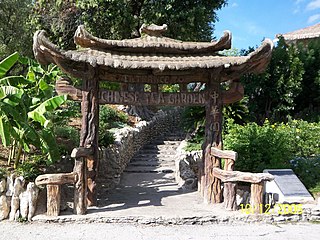
Dionicio Rodríguez (1891–1955) was a Mexican-born artist and architect whose work can be seen in Alabama, Arkansas, Illinois, Maryland, Michigan, New Mexico, Tennessee, and Texas, as well as Washington, D.C., and Mexico City.
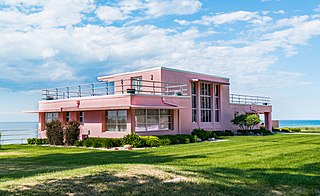
The Century of Progress Architectural District is a historic district in Beverly Shores, Indiana. The district is on Lake Shore Drive within the Indiana Dunes National Park. The district comprises five buildings, all from the Homes of Tomorrow Exhibition of the 1933 Century of Progress World's Fair which took place in Chicago. Intended to display the future of housing, the Century of Progress Homes reflect a variety of designs, experimental materials and new technologies. On June 30, 1986, the district was listed on the National Register of Historic Places as the Beverly Shores–Century of Progress Architectural District.
There are 96 sites in the National Register of Historic Places listings in North Side Chicago — of more than 350 listings within the City of Chicago, in Cook County, Illinois.
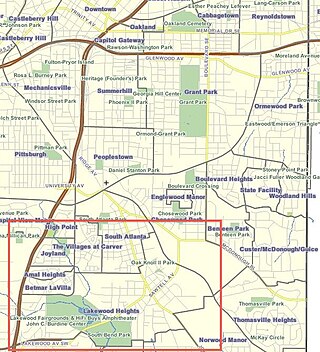
Lakewood Heights is a primarily Black neighborhood in southeast Atlanta. It is bounded by:
Frank Carmean was an architect in Arkansas. Not formally trained as an architect, but rather experienced in building construction, he became a designer. He joined a firm in 1927 that was developing the Edgemont residential area of Little Rock, and is believed to have designed all but one of the 16 homes in the development. The firm billed him as their "architect", and he toured to collect new designs. He introduced or expanded the use of Spanish Colonial architecture in Little Rock.
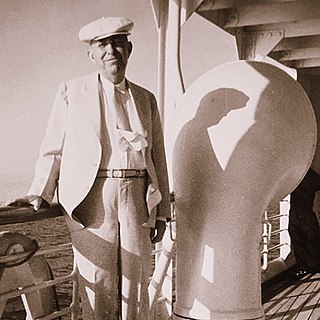
Justin Matthews (1876–1955) was an Arkansas road and bridge builder and real estate developer. He helped to design and expand many areas in central Arkansas.

The Carlton House is a historic house located at 434 South Lakeshore Drive in Lake Village, Arkansas.
The Sam Epstein House is a historic house at 488 Lakeshore Drive in Lake Village, Arkansas. The Colonial Revival house is notable for its association with Sam Epstein, a Jewish immigrant who was one of Lake Village's first shopkeepers, and eventually amassed more than 10,000 acres (4,000 ha) of land in Chicot County devoted to agricultural purposes. He was active in the civic and economic life of the community, supporting others in the development of business opportunities.
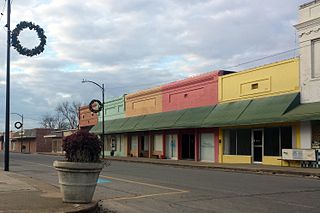
The Lake Village Commercial Historic District encompasses the historic commercial heart of Lake Village, Arkansas, the county seat of Chicot County in the Mississippi River delta region of southeastern Arkansas. The district covers about six square blocks of downtown Lake Village, bounded roughly by Jackson Street to the north, Lakeshore Drive to the east, Church Street to the south, and Chicot Street to the west. This area represents the growth of Lake Village during its period of greatest prosperity, between 1906 and 1960. The city's growth was spurred by the arrival of the railroad in 1903, and most of the district's buildings were built between 1900 and 1930. Most of the buildings are vernacular commercial buildings; the John Tushek Building at 202 Main Street is one interesting example of Beaux Arts styling, and 218–222 Main Street has some Italianate styling. The district includes the Lake Village Confederate Monument, which has been a local landmark since 1910.

The Lake Village Confederate Monument is located on the median of Lakeshore Drive, between Main and Jackson Streets in Lake Village, Arkansas. The marble monument depicts a Confederate Army soldier standing in mid stride with his left foot forward. His right hand holds the barrel of a rifle, whose butt rests on the monument base. He carries a bedroll draped over his left shoulder, and wears a Confederate cap. A cannon that served as a fountain was once part of the sculpture, but is now missing. The statue is about 6 feet (1.8 m) high and 2 feet (0.61 m) square; it rests on a marble foundation that is 20 feet (6.1 m) long, 12 feet (3.7 m) wide, and 8 feet (2.4 m) high. The monument was erected in 1910 by two chapters of the United Daughters of the Confederacy at a cost of about $3,000.

The Edgemere Street Bridge is a historic bridge in North Little Rock, Arkansas. It carries Edgemere Street over a small part of Lakewood Lake Number Three. It is a masonry structure with closed spandrels, and has a span of about 18 feet (5.5 m) and a total length of 57 feet (17 m). It is built out of rustic, roughly squared fieldstone, that is laid in uncoursed fashion. Vertical columns project from either side of the spandrels, rising above the deck level to form a decorative parapet. It was built, along with the similar Lakeshore Drive Bridge as part of the innovative Lakewood Development project of developer Justin Matthews in the 1930s.

The Lakeshore Drive Bridge carries a closed-off portion of Lakeshore Drive across a tributary stream on the west side of Lake Number 3 in North Little Rock, Arkansas. It is a stone arch bridge with closed spandrels and a total structure length of 53 feet (16 m). The bridge consists of a single elliptical curved arch, which spans 20 feet (6.1 m) and is 5 feet (1.5 m) high. Rustic square stone columns rise from the spandrels, creating uneven parapets on the sides of the structure. The bridge was built in the late 1930s along with Edgemere Street Bridge as part of developer Justin Matthews' construction of the Lakewood area. It is one of a small number of documented masonry arch bridges in the state.

The Grand View Lodge is a resort on Gull Lake in Nisswa, Minnesota, United States. Established in 1916, it has grown to include seven restaurants, a spa, two golf courses, a conference center, and over 200 guest cabins. Two of the complex's buildings were listed together on the National Register of Historic Places in 1980 for having local significance in the themes of architecture and entertainment/recreation. They were nominated for displaying some of north-central Minnesota's most elaborate rustic log architecture, and for the older building's status as one of the region's earliest resort lodges.

Lakewood Farm, also known as the Getz Zoo, Getz Farm, or Lakewood Zoo, is a house and outbuildings located at 264 Lakeshore Avenue in Holland, Michigan. The property was placed on the National Register of Historic Places in 2020.



















